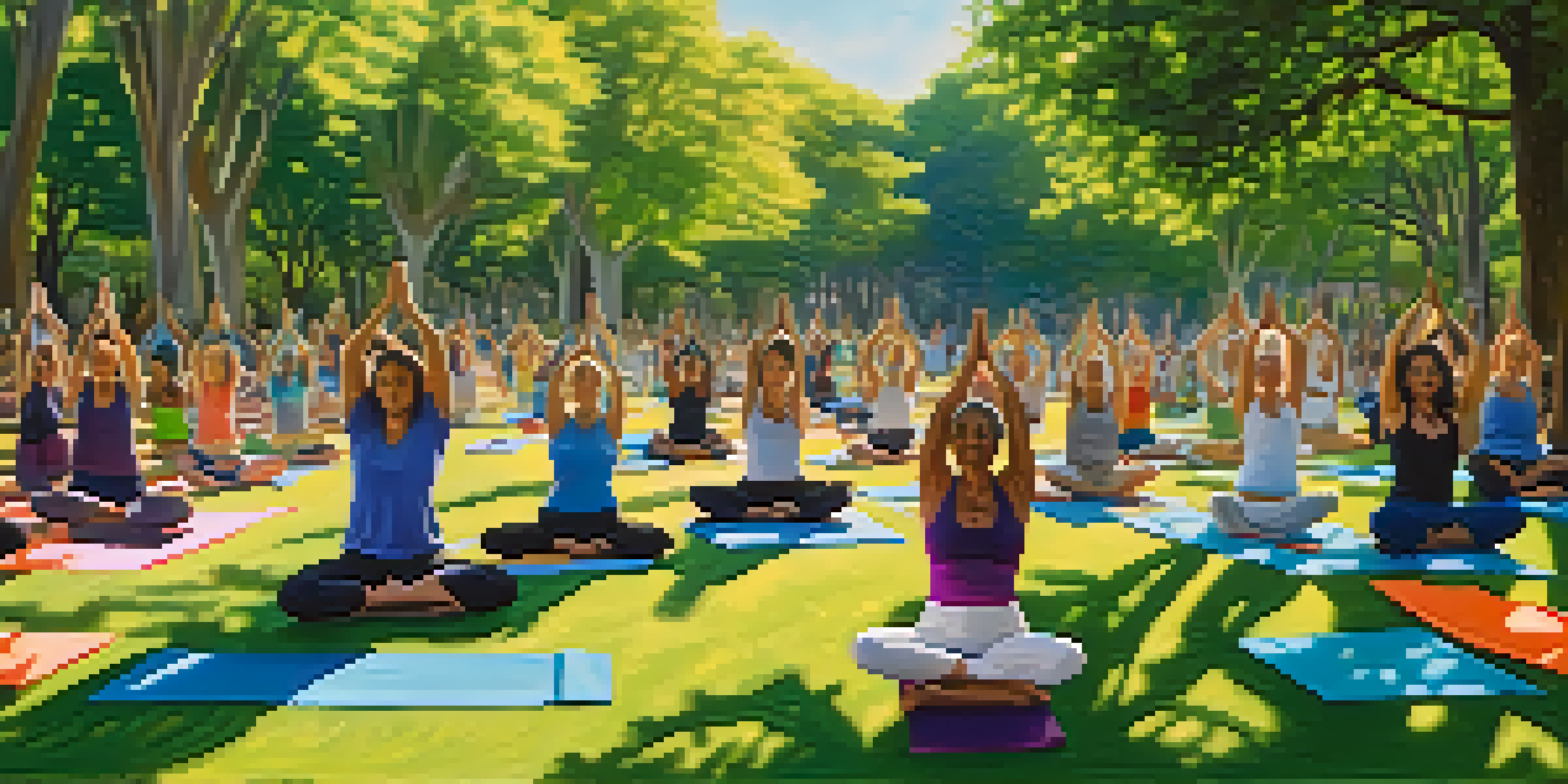Yoga and Intersectionality: Bridging Diverse Activism Styles

Understanding Yoga's Roots in Inclusivity and Community
Yoga is often seen as a personal practice, but its roots run deep in community and inclusivity. Traditionally, yoga was about collective well-being, emphasizing harmony among individuals. This foundational aspect of yoga aligns beautifully with intersectionality, which advocates for recognizing diverse identities and experiences.
Yoga teaches us to cure what need not be endured and endure what cannot be cured.
When we practice yoga, we’re not just stretching our bodies; we’re also engaging in a practice that has historically been about connection. Many of yoga's teachings encourage practitioners to look beyond their own experiences and understand the struggles of others. This shared journey can foster empathy and solidarity among diverse groups.
By embracing the communal aspects of yoga, practitioners can create spaces that welcome everyone, regardless of their background. This inclusiveness is crucial in activism, where understanding various perspectives can lead to more effective and unified movements.
Intersectionality: The Key to Understanding Diverse Experiences
Intersectionality, a term coined by Kimberlé Crenshaw, refers to the interconnected nature of social categorizations such as race, gender, and class. Understanding this concept is vital for activists and yoga practitioners alike, as it highlights how overlapping identities influence experiences of oppression and privilege. Without acknowledging these intersections, movements can inadvertently marginalize voices that don’t fit a single narrative.

In yoga, recognizing intersectionality allows for a more inclusive practice. For example, a yoga studio that acknowledges different body types, abilities, and cultural backgrounds can attract a broader audience. This creates an enriching environment where everyone feels valued and understood.
Yoga Fosters Community and Inclusivity
Yoga's roots in community help create spaces that welcome diverse identities and promote empathy among practitioners.
By weaving intersectionality into our yoga practice, we can foster a sense of belonging that transcends societal divides. This understanding is essential for activism, as it encourages collaboration and support among various groups fighting for social justice.
How Yoga Practices Promote Mindfulness in Activism
Mindfulness is a key component of yoga, helping practitioners become more aware of their thoughts and feelings. This heightened state of awareness can significantly enhance one's approach to activism. When activists practice mindfulness, they can respond thoughtfully rather than react impulsively, leading to more constructive conversations and actions.
The most difficult times for many of us are the ones we give ourselves.
For instance, a mindful activist can approach discussions about social issues with empathy and open-mindedness, facilitating better understanding among diverse groups. This quality is especially important when dealing with complex intersectional issues, where emotions can run high. Mindfulness allows for patience and compassion, essential ingredients for effective activism.
Moreover, integrating mindfulness into activism can prevent burnout. Activists often face overwhelming challenges, and yoga provides tools to manage stress and maintain balance. This self-care aspect is vital, ensuring that activists remain resilient and focused on their goals.
Creating Safe Spaces: The Role of Yoga in Activism
Safe spaces are crucial for fostering open dialogue and growth within activist communities. Yoga can play a significant role in creating these environments, allowing individuals to express themselves without fear of judgment. By practicing yoga together, participants can build trust and camaraderie, essential for effective collaboration.
In these safe spaces, individuals from diverse backgrounds can share their experiences and perspectives, enriching the collective understanding of issues at hand. For example, a community yoga class that welcomes all identities can serve as a platform for discussing intersectional challenges and solutions. This not only empowers participants but also strengthens the movement as a whole.
Intersectionality Enhances Yoga Practice
Recognizing intersectionality in yoga allows for a more inclusive environment that values varied identities and experiences.
Ultimately, yoga cultivates a sense of belonging that can extend beyond the mat. By promoting inclusivity and understanding, yoga practitioners can contribute to a more unified and supportive activist community.
Storytelling: Amplifying Marginalized Voices Through Yoga
Storytelling is a powerful tool in both yoga and activism, allowing individuals to share their unique experiences and struggles. By encouraging participants to share their stories during yoga classes or workshops, instructors can amplify marginalized voices. This practice not only validates individual experiences but also fosters a deeper connection among participants.
For instance, a yoga session that incorporates storytelling can help participants understand the challenges faced by others in the room. This exchange of narratives can lead to greater empathy and a collective commitment to social change. It highlights the importance of listening and learning from diverse perspectives.
Furthermore, storytelling within the yoga community can inspire action. When individuals hear about the experiences of others, it can ignite a passion for activism and a desire to advocate for change. This synergy between yoga and activism creates a powerful platform for social justice.
Yoga as a Tool for Healing in Activist Communities
Activism can take a toll on mental and emotional well-being, making healing practices essential for those involved. Yoga offers an avenue for healing, allowing activists to reconnect with their bodies and minds. This restorative aspect of yoga can be particularly beneficial for individuals who have faced trauma or burnout in their activism efforts.
Incorporating yoga into activist spaces promotes self-care and resilience. For example, a community retreat that combines yoga with discussions on social justice can provide participants with tools to recharge and refocus. This holistic approach to activism recognizes the importance of mental health and well-being.
Mindfulness Supports Effective Activism
Practicing mindfulness in yoga equips activists with the awareness needed for thoughtful engagement and resilience in their efforts.
Ultimately, healing through yoga can empower activists to continue their work with renewed energy and purpose. It encourages a sustainable approach to activism, where self-care is an integral part of the journey toward social change.
The Future of Yoga and Intersectional Activism
As we look to the future, the intersection of yoga and activism is poised to evolve. With increasing awareness of social issues, more yoga practitioners are embracing the principles of intersectionality. This shift is encouraging a more inclusive and diverse yoga community that reflects the world we live in.
Moreover, as yoga continues to grow as a global practice, it has the potential to serve as a unifying force. By bridging diverse activism styles, yoga can foster collaboration among groups working towards common goals. This collaborative spirit can lead to innovative solutions and impactful change.

In conclusion, the future of yoga and intersectional activism is bright. By embracing inclusivity, mindfulness, and healing, we can create a more equitable and compassionate world, one yoga mat at a time.